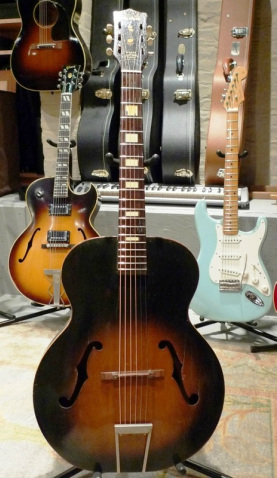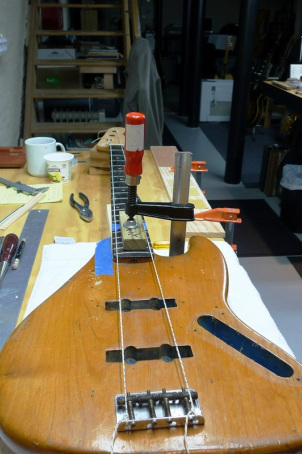It is not often that I take the time to photograph repair work. The examples on this page are among a few exceptions. This 1960s Harmony Master was found in a basement and brought to me in a plastic garbage bag. It was it bad shape.
|
I thought this old Harmony Master might be worth fixing since they were made from all solid wood and were pretty good sounding guitars. The birch top and back were "pressed" (as opposed to carved). After a thorough cleaning, I addressed the body cracks, open joints, reset the neck, made some faux binding where it was missing and had been patched with what appeared to be bathtub caulking.
I replaced some and dressed all the frets, and made a new nut, bridge and saddle. The finish was cleaned, restored and polished and the old finish blended with new material where necessary. The structural integrity of the neck joint is not perfect, partially due to the fact that pine was used, which is not only too soft but it didn't age well, so I used light gauge Martin 'silk and steel' strings and it has remained stable. It does have the "steel reinforced neck" but not an adjustable truss rod. The result is now a guitar that plays well, looks good, sounds good and has a happy owner who keeps it hanging on the wall of his living room. |
|
|
Below is 'Stumpy', a '64 J-bass that had a wing amputated prior to when it was purchased by a dear friend in 1968...
|
In the tradition of Leo's fondness for Cadillac colors, this '64 J-bass was originally Sherwood green, including its headstock. The original owner, for some unknown reason, cut off the upper wing and stripped the original finish. The headstock decal was unfortunately also removed in the process.
The neck had shifted badly to the west, the bridge pickup wasn't working and the wiring was modified poorly. In addition to that the hardware was badly rusted and some knobs and pots were not original. Due to the fact that the low E tuner hole was drilled in the wrong place (in the factory), screws had been inserted into the headstock to prevent the low E string from popping out of the nut slot. I reworked the neck pocket for proper neck alignment and plugged the badly located tuner hole and re-drilled it in the right place. (The flange of the tuner bushing covers the new wood.) The bridge pickup was rewound and the wiring redone to vintage spec and knobs and pots replaced with period-correct parts. The neck itself was basically in very good shape, as were the original frets, and only needed a good cleaning, some fret leveling and dressing. The original nut was fine but the string slots needed adjusting. It now plays, feels and sounds like a classic vintage J-bass. |
|
|
©2012-2020. Femenella Custom™ www.femenellacustom.com info@femenellacustom.com
Fender Stratocaster®, Telecaster®, Esquire® and Nocaster® are registered trademarks of the Fender Musical Instruments Corp.
Gibson and Gibson Les Paul® are registered trademarks of Gibson Musical Instruments.



